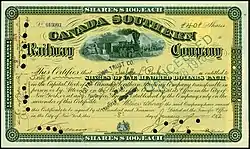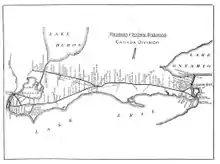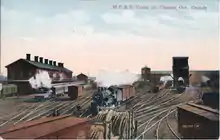Canada Southern Railway
The Canada Southern Railway (reporting mark CASO), also known as CSR, was a railway in southwestern Ontario, Canada, founded on February 28, 1868 as the Erie and Niagara Extension Railway.[1] Its name was changed to Canada Southern Railway on December 24, 1869.[2] The 1868 Act specified that it was to be constructed at a broad gauge of 5 ft 6 in (1,676 mm),[3] but that requirement was repealed in the 1869 Act,[4] thus allowing construction at the standard gauge of 4 ft 8+1⁄2 in (1,435 mm).
 Share of the Canada Southern Railway Company, issued 8 January 1912. | |
| Overview | |
|---|---|
| Stations operated | St. Thomas |
| Parent company | Michigan Central Railroad |
| Headquarters | St. Thomas, Ontario |
| Reporting mark | CASO |
| Locale | Southern Ontario |
| Technical | |
| Track gauge | 1,435 mm (4 ft 8+1⁄2 in) standard gauge |
The railway was leased to the Michigan Central Railroad (MCR) for 99 years in 1883; in 1929 it was subleased to the New York Central Railroad (NYC). Its successors Penn Central (formed 1968) and Conrail (formed 1976) later exercised control before being sold to Canadian National Railway/Canadian Pacific Railway in 1985.
History
Background
The line was originally conceived by Kenyon Cox (brother of Jacob Dolson Cox, Governor of Ohio), Daniel Drew, Sidney Dillon and John F. Tracy to connect with the Wabash Railroad and establish a railway network extending from Lake Erie to the Mississippi River.[5]
The Panic of 1873 was responsible for the failure of several large railroads in North America, together with their financial backers. In addition to the CSR, the Missouri, Kansas & Texas Railroad, Northern Pacific Railroad, Chesapeake & Ohio Railroad and New York and Oswego Midland Railroad were also affected.[6]
The CSR's banker, Kenyon, Cox & Co. (of which Drew was general partner) failed, and its bonds were subsequently protested, although some observers felt that the move was unnecessary.[6] CSR subsequently became insolvent, as it was unable to redeem the bonds. Within two years, it was taken over by the railroad magnate Cornelius Vanderbilt at essentially no cost other than taking on the guarantee of them.[5]
When Cornelius died in 1877, his son, William Henry Vanderbilt, became head of the Vanderbilt railroad empire.[5] The younger Vanderbilt took steps to separate the various railroad properties he controlled. On 1 January 1883, the New York Central Railroad (NYC) was able to lease the CSR to another Vanderbilt railroad company, the Michigan Central Railroad (MCR), on a 21-year renewable term. Vanderbilt, who owned all three companies, ensured that each one operated independently, through its own autonomous president and board of directors.[7] In 1929, MCR subleased CSR to NYC, its parent company.
Development of the line

The company was originally authorized to construct a railway line between Fort Erie and Sandwich (Windsor), with a branch line to Amherstburg.[8] A second branch line was authorized in 1869 between St. Thomas and Sombra the following year.[9] Other significant subsequent legislation included:
| Act | Significant provisions |
|---|---|
| The Canada Southern Railway Act, 1872, S.O. 1871-2, c. 48 | |
| The Canada Southern Railway Act, 1873, S.O. 1873, c. 86 |
|
| The Canada Southern Railway Act, 1874, S.O. 1874 (1st Sess.), c. 41 |
|
| An Act respecting the Canada Southern Railway Company, S.C. 1874, c. 68 |
|
| An Act to authorize the Canada Southern Railway Company to acquire the Erie and Niagara Railway Company, and for other purposes, S.C. 1875, c. 66 |
|
| The Canada Southern Arrangement Act, 1878, S.C. 1878, c. 27 |
|
| An Act to confirm a certain Agreement made between the Grand Trunk Railway of Canada, the Canada Southern Railway Company, and the London and Port Stanley Railway Company, S.O. 1888, c. 67 |
|
| An Act to confirm a certain Agreement made between the London and South Eastern Railway and the Canada Southern Railway Company, S.O. 1888, c. 69 |
|
There was an attempt in 1883 to amalgamate the CSR with the Credit Valley Railway,[13] which was dropped when the CVR opted to merge with the Ontario and Quebec Railway instead.[14]
Corporate headquarters

CSR's headquarters were located in St. Thomas, Ontario. The site was chosen because St Thomas was roughly equal-distance between Windsor and Fort Erie, Ontario and the city offered a $25,000 bonus to the railroad company as an incentive to build within city limits.[15] CSR's main building, the Canada Southern Railway Station, included a passenger station and dining room on the ground floor with the railway's head offices on the upper floor. The extremely long, narrow building was based on Italianate architecture and is the only known train station in Canada to embody this style.[15] The station was the design of Canadian architect Edgar Berryman (1839-1905).[15]
Car shops and locomotive manufacturing
A large car shop, located in the yard, facilitated the manufacture of cars and allowed repairs to be made to locomotives. Steam locomotives were also manufactured for CSR in the car shop, beginning in 1882[16][17] and closed sometime after 1905. Types of locomotives made included:
- B-82b Class - Type 0-6-0
- B-82d Class - Type 0-6-0
- B-84 Class - Type 0-6-0
- B-84b Class - Type 0-6-0
- F-81c Class - Type 4-6-0
- F-82f Class - Type 4-6-0
- F-82 Class - Type 4-6-0
- F-82a Class - Type 4-6-0
- G-80e Class - Type 2-8-0
Initially all locomotives were built for use by CASO, but some ended their career with the New York Central Railroad.[18]
Later years
The CSR was never completely controlled by the New York Central (later part of Penn Central) or the Michigan Central, as the two together held only about 107,000 of the 150,000 shares outstanding, and the rest were publicly held.[19] The shareholders had received dividends in every year from 1887,[19] and an extraordinary dividend in 1976 triggered a legal dispute that was not resolved until 1983.[20]
On April 30, 1985, the Canadian National Railway and Canadian Pacific Railway jointly purchased the former CASO from Conrail in order to acquire the Michigan Central Railway Tunnel under the Detroit River and the Michigan Central Railway Bridge at Niagara Falls.[21]
Much of the CASO has been downgraded, abandoned or removed by CN and CP over the years. Operations through Niagara Falls (and over the MCRR bridge) were discontinued with that portion of the line through the city removed in 2001. Unlike the rest of the line, however, the Detroit River tunnel is a key part of freight movements across the Canada-US border and still sees a good number of mainline trains.
The CASO rarely operated its own rolling stock after acquisition, and its reporting mark was abolished in 1977.
See also
Notes
- a group of American bondholders disputed the scheme's application to them, which was dismissed by the Supreme Court of the United States in 1883[10]
References
- An Act for the incorporation of the Erie and Niagara Extension Railway, S.O. 1868, c. 14
- The Canada Southern Railway Act, 1869, S.O. 1869, c. 32
- 1868 Act, s. 16
- 1869 Act, s. 11
- Edwards, E.J. (November 4, 1910). "New Chronicles: The Railroad That Was Given Away For a Guarantee of Bonds". Pittsburgh Gazette-Times.
- History of the Terrible Financial Panic of 1873: Downfall of the Money Kings. 1873. pp. 16–18.
- Smith, Douglas N.W. (2002). New York Central's Canadian streamliners: a history of the New York-Detroit-Chicago passenger trains in the 19th and 20th centuries. Ottawa: D.N.W. Smith. p. 26. ISBN 0-9730521-0-4.
- 1868 Act, s. 3
- 1869 Act, s. 4
- Canada Southern Ry. Co. v. Gebhard, 109 U.S. 527 (1883)
- concurrent federal authorization granted with S.C. 1888, c. 36
- concurrent federal authorization granted with S.C. 1888, c. 40
- An Act respecting the Credit Valley Railway Company, S.O. 1882-3, c. 50
- An Act to amend an Act to incorporate the Ontario and Quebec Railway Company, S.C. 1883, c. 58
- "St. Thomas Canada Southern Railway Station" (PDF). Ontario Heritage Trust. 2011. Archived from the original (PDF) on 2013-09-21. Retrieved 2013-08-30.
- Tennant, Robert D. (1991). Canada Southern Country. Erin: Boston Mills Press. ISBN 1-55046-007-2.
- Grant, Laurence (2011). Canada Southern Railway Station. St. Thomas: North America Railway Hall of Fame. ISBN 978-0-9878271-0-4.
- "Canada Southern Photo Page".
- "Double or Something". Milwaukee Sentinel. March 31, 1976.
- Canada Southern Railway Co v. Michigan Central Railroad Co et al, 1983 CanLII 1884, 45 OR (2d) 257 (23 December 1983), Superior Court of Justice (Ontario, Canada)
- "Significant dates in Canadian railway history". Colin Churcher's Railway Pages. 2006-03-17. Archived from the original on 2006-08-29. Retrieved 2006-04-26.
Further reading
- Neutel, Walter (1969). From Southern Concept to Canada Southern Railway, 1835-1873 (M.A.). University of Western Ontario.
External links
- "Canada Southern Railway". canadasouthern.com.
- "Canada Southern Railway (timetable)". August 1882.
- St Thomas